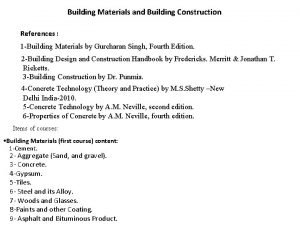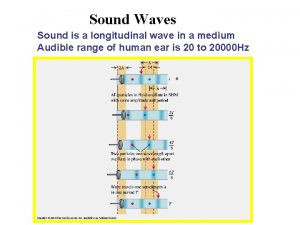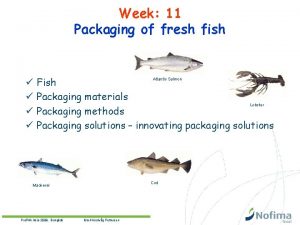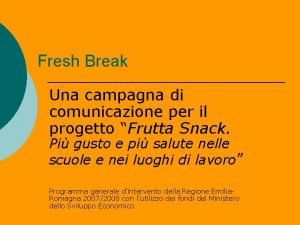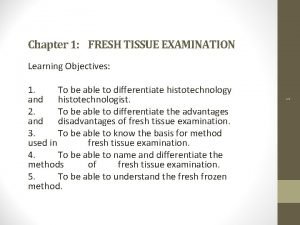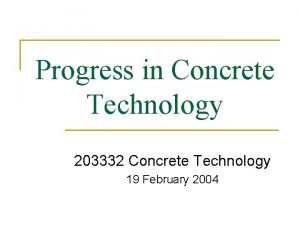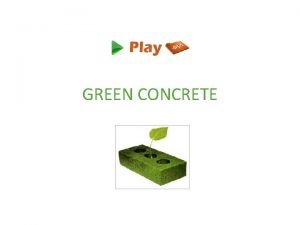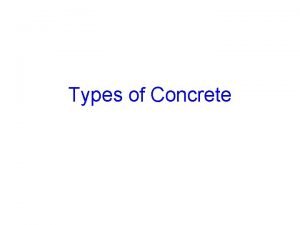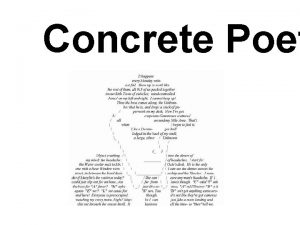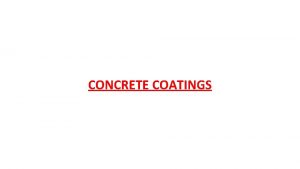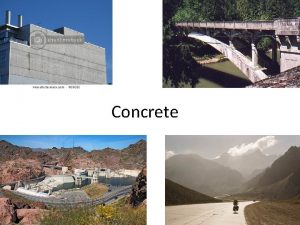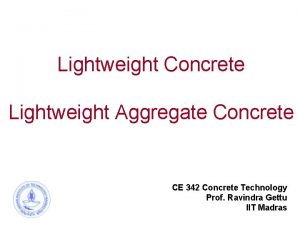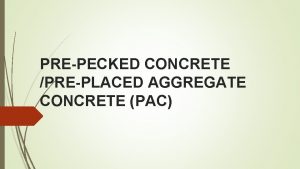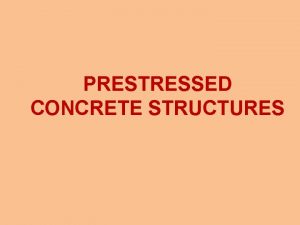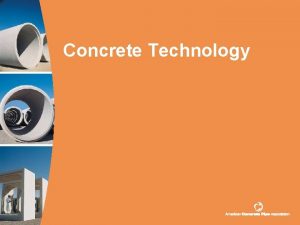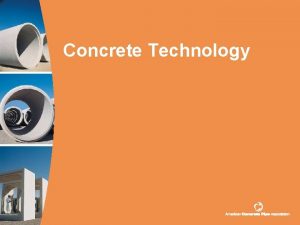CONCRETE TECHNOLOGY UNIT II FRESH CONCRETE FRESH CONCRETE























































- Slides: 55

CONCRETE TECHNOLOGY UNIT II FRESH CONCRETE

FRESH CONCRETE �It is a hardened concrete well defined w. r. to shape, finish, strength, durability, shrinkage & creep. The requirement may be summarized as: 1. Be easily mixed and transported. 2. Have good finishing characteristics. 3. Have the ability to be compacted without excessive loss of energy. 4. Workability

Dia. Of fresh concrete

Dia. Of fresh concrete

� Workability: - The ease with which the concrete can be mixed with minimum quantity of water is transported, placed, mixed, compacted & finished.

Having two parameters: �Consistency: - Major factors affecting consistency are 1. water content 2. cement content 3. aggregate content 4. air content 5. mix proportion 6. chemical admixture �Homogeneity: Means uniform and stable distribution of cement, aggregate and water.

Workability, a term applied to many concrete properties, can be adequately measured by three characteristics: 1. Compatibility: - The ease with which the concrete can be compacted and air void removed.

2. Mobility: - Ease with which concrete can flow into forms and around reinforcement. 3. Stability: - Ability for concrete to remain stable and homogeneous during handling and vibration without excessive segregation.

Measurements of Workability �The following tests are widely used for measurement: 1. Slump test 2. Compacting factor test 3. Vee - Bee consistency test 4. Flow test

Slump Test The oldest, most widely used test for determining workability. ØThe device is a hollow cone-shaped mold. The mold is filled in three layers of each volume. ØEach layer is rodded with a 16 mm steel rod 25 times. Ø

ØThe mold is then lifted away and the change in the height of the concrete is measured against the mold. The slump test is a measure of the resistance of concrete to flow under it own weight.

Procedure of Slump Test

After doing slump test measure the height of concrete

There are three classifications of slump: v True slump v Shear slump v Collapse slump

�True slump is a general reduction in height of the mass without any breaking up. �Shear slump indicates a lack of cohesion, tends to occur in harsh mixes. This type of result implies the concrete is not suitable for placement. �Collapse slump generally indicates a very wet mix. With different aggregates or mix properties.

Compaction Test § Concrete strength is proportional to its relative density. § A test to determine the compaction factor was developed in 1947. § It involves dropping a volume of concrete

Compaction Test It consist of i) Two hopper vessel A & B having door at bottom ii) Cylindrical vessel C is placed below the hopper B. It is measured by Density Ratio.


Procedure : a)Vessel A is filled with sample of concrete b)Door at bottom of A is opened & concrete falls into the vessel B. c)Bottom door vessel B is opened so that concrete falls into cylinder C. d)Content of cylinder are weighted as W 1. e)Cylinder is again filled up with the W 2. Compaction factor= W 1/W 2 i. e. wt. of partially compacted concrete/ wt. of fully compacted concrete

Vee-bee Test q A standard slump cone is cast, the mold removed, and a transparent disk placed on top of the cone. q The sample is then vibrated till the disk is completely covered with mortar. q The time required for this is called the Vebe time.

Water/Cement Ratio

Water/Cement Ratio: v. It is main factor which is responsible for the Workability of concrete. v. When w/c ratio is more, Workability of concrete increases because more water will be available for the lubrication purpose which helping in rolling aggregate easily. v. W/C ratio is more, Shrinkage of concrete is more.

w/c ratio α workability α 1/strength

Segregation and Bleeding

Segregation: � It refers to a separation of the components of fresh concrete, resulting in a non-uniform mix. This can be seen as a separation of coarse aggregate from the mortar, caused from either the settling of heavy aggregate to the bottom or the separation of the aggregate from the mix due to improper placement. Some factors that increase segregation are:

�Larger maximum particle size (25 mm) and proportion of the larger particles. �High specific gravity of coarse aggregate. �Decrease in the amount of fine particles. �Particle shape and texture. �Water/cement ratio. �Good handling and placement techniques are most important in prevention of segregation.

Bleeding: �It is defined as the appearance of water on the surface of concrete after it has consolidated but before it is set. �Since mixing water is the lightest component of the concrete. Bleeding is generally the result of aggregates settling into the mix and releasing their mixing water. �Some bleeding is normal for good concrete. The upper layers will become too rich in cement with a high w/c ratio causing a weak, porous structure.

Bleeding may be reduced by: �Increasing cement fineness. �Increasing the rate of hydration. �Using air-entraining admixtures. �Reducing the water content.

VOIDS

Voids: - The empty space between the aggregate partials are termed as voids. Void ratio= Bulk density/ sp. gravity

Permeability

Permeability: It is governed by porosity i. e. It is defined as the property that governs the rate of flow of a fluid into a porous solid. i. e. the consequence of the w/c ratio of the concrete mix. Important for the following factor: a) The penetration by materials in solution may adversely affect the durability of concrete. b) The moisture penetration depends on permeability & if the concrete can become saturated with water.

In concrete, water is a necessary ingredient for the cement hydration reactions and an agent that facilitates the mixing of the components of concrete, water is present from the beginning. Gradually, most of the evaporable water in concrete is lost, leaving the pores empty or unsaturated. It depends on the hydraulic conductivity, which is also known as the coefficient of permeability (K).

The permeability of cement paste also varies with the age of concrete or with the degree of hydration. In the hydration of cement paste permeability is lower with lower w/c ratio. It can be measured by a simple test, Darcy’s law : The coefficient of permeability K is determined from Darcy's expression: Dq/dt = K (∆ H A)/(Lν) where Dq/dt is the rate of fluid flow (ml/s), ν the viscosity of the fluid , ∆ H the pressure gradient (mm), A the surface area (mm 2), and L the thickness of the solid (mm).

CURING: -

CURING can be described as the process of maintaining a satisfactory moisture content and A favorable temperature in concrete during the period immediately following placement. It depends on the condition on the site, size, shape and position of the member.

Methods of Curing Concrete curing methods may be divided broadly into four categories: �Water curing �Membrane curing �Application of heat �Miscellaneous

Water curing: v Covering the concrete with wet burlap (Coarse jute fabric). v Covering the surface with water proof paper v Sprinkling of water.

Membrane curing: v The membrane curing serves as a physical barrier to prevent loss of moisture from the concrete to be cured.

Application of heat: v Chemical curing: It is done by spraying the sodium silicate solution for preventing evaporation of water. v For Temperature: It is raised by i. Placing the concrete in steam. ii. Placing the concrete in hot water. iii. passing an electric current through the concrete.


Creep in concrete �Concrete creep is defined as Deformation of structure under sustained load. �This deformation usually occurs in the direction the force is being applied. �Creep is factored in when concrete structures are designed. Factors Affecting Creep : � Aggregate �Mix Proportions �Age of concrete

Compaction Methods: �Hand Roding: - the process of ramming the concrete manually with heavy flat-faced tool. �Mechanical Vibration: - the vibration can be imparted by vibrators which are operated with the help of an electric motor or diesel engine. Types of vibrators: a. vibrating table b. Surface vibrator c. Shutter vibrator �High pressure and shock












 Unit 6 review questions
Unit 6 review questions Concrete semi concrete abstract
Concrete semi concrete abstract Concrete semi concrete abstract
Concrete semi concrete abstract Maturity of concrete
Maturity of concrete Construction references
Construction references Unit 8 ecommerce p2
Unit 8 ecommerce p2 What material does not conduct electricity
What material does not conduct electricity Cape information technology unit 1 notes
Cape information technology unit 1 notes Unit 8 technology
Unit 8 technology Unit 1 technology in use
Unit 1 technology in use Unit 1 technology in use
Unit 1 technology in use Information technology unit 4
Information technology unit 4 Unit 5 technology and you
Unit 5 technology and you Unit 2 relationship
Unit 2 relationship Unit 2 materials technology
Unit 2 materials technology Unit 3 lesson 12 information technology
Unit 3 lesson 12 information technology Information technology unit 2
Information technology unit 2 Fresh frozen plasma contents
Fresh frozen plasma contents Fresh frozen plasma vs platelets
Fresh frozen plasma vs platelets Tongue twister fish
Tongue twister fish Whats a longitudinal wave
Whats a longitudinal wave Qualities of shellfish
Qualities of shellfish Quality control of fresh fruits and vegetables
Quality control of fresh fruits and vegetables Fresh frozen plasma vs platelets
Fresh frozen plasma vs platelets Three market forms of meat
Three market forms of meat Color 12212008
Color 12212008 Cryoprecipitate
Cryoprecipitate Freshman english 1
Freshman english 1 Fresh x beispiele
Fresh x beispiele Rumus fwa
Rumus fwa Dessert in french classical menu means
Dessert in french classical menu means Market forms of crustaceans
Market forms of crustaceans Fresh water density
Fresh water density Debris flow
Debris flow Fresh frozen plasma transfusion time
Fresh frozen plasma transfusion time Fresh frozen plasma transfusion time
Fresh frozen plasma transfusion time Fresh oil new wine
Fresh oil new wine The japanese have always loved
The japanese have always loved Two classification of shellfish
Two classification of shellfish Redemption sequence
Redemption sequence Fresh fruits and vegetables importers in germany
Fresh fruits and vegetables importers in germany Fresh and saltwater systems grade 8 test
Fresh and saltwater systems grade 8 test Fresh fish packaging
Fresh fish packaging What are quantifiers
What are quantifiers Fresh break
Fresh break A fresh anointing
A fresh anointing Fresh water meets salt water
Fresh water meets salt water Advantages of fresh tissue examination
Advantages of fresh tissue examination Fresh logi
Fresh logi Fresh man logic
Fresh man logic God gives us a fresh start
God gives us a fresh start People who own, operate, and take the risk of a business
People who own, operate, and take the risk of a business Generates fresh produce and other farm products
Generates fresh produce and other farm products Generates fresh produce and other farm products
Generates fresh produce and other farm products Fresh lemonade physical or chemical change
Fresh lemonade physical or chemical change Weaknesses of tesco
Weaknesses of tesco




